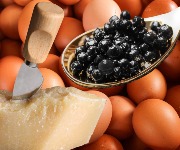All the Trimmings
No Christmas spread is complete without Cranberry sauce. Even if you're not an avid fan of the sour-tasting, sharp fruit relish, its blood-red red hue makes for a festive addition to any table.
At the risk of unnerving my Christmas Day hosts with only a handful of days remaining until I take up my seat around their table, I have to admit, I'm not a huge fan of turkey.
Perhaps it’s that I’ve missed out on building a close rapport with the bird - after all, the game Italians eat on Christmas Day rarely takes the form of the 'traditional British turkey', and more importantly, always arrives in a lowly second place after a sumptuous and much more arresting first course of pasta.
But without its trusty trimmings, there is an undeniable lack of flavour in the stringy, colourless meat turkey serves up. And if we are all honest, rare is it that our strands of perfectly-carved meat sit on the prongs of our forks on their own, for if it's not squashed on with stuffing, shavings of Brussels sprouts, storks of carrots and parsnips, they will otherwise be doused in quite a lot of gravy.
Oh yes, because as aware as we are with the notion that Christmas is an unavoidable all-you-can-eat, guilt-inducing culinary thoroughfare, we still manage to cancel out the health benefits of the leanest thing around all festive weekend, by dunking it in a thick array of flavour-boosting sauces.
So for those of us disinclined to have a nude turkey this Christmas, these are some of its best support acts.
Bread Sauce
It sometimes resembles a neglected vat of porridge, or even, a lumpy rice pudding. Thankfully, it is neither and instead, this fragrant infusion of cloves, cream, and peppercorn is one of our favourite and most classic of Christmas condiments. But if you are to dress up your roast turkey with the white stuff, be sure to leave enough time to make your own. Why? Because bread sauce - whose cloves can easily be replaced by the less pungent nutmeg - is the great casualty of busy cooks who are now turning to the pale granules in instant packets to achieve their results. The imitator is however really quite bland, and if, like me, you feel the turkey is in desperate need of an injection of flavour, the use of a sachet-sauce will leave you wishing you could remember where you put the ketchup. You need a good recipe and enough time for preparation. It's worth it.
Cumberland Sauce
We often think of this condiment as one for gammon or venison, but this fruit-based sauce, and its content of lemon juice, oranges, port and redcurrant jelly is these days beginning to make its name as a Christmas sauce. Sweet and tangy in equal measure, its citrus aromas will give your turkey somewhat of a jolt (in case you're cooking for the first time and fearing the taste of your bird, this may be suitable to hide behind). Fine to be served cold, easy to make at home, Cumberland Sauce is, as chefs call it, the perfect larder sauce (provided you have all the above ingredients sitting on your domestic shelves).
Cranberry Sauce
No Christmas spread is complete without Cranberry sauce. Even if you're not an avid fan of the sour-tasting, sharp fruit relish, its blood-red red hue makes for a festive addition to any table.
To put together, one needs a batch of cranberries, white wine, caster sugar, orange zests and splashes of port. Its arresting colour and citrus taste will, from there, take care of itself. That said, with it being such a favourite, the cranberry sauce sold in supermarkets is equally palette-pleasing. Jar-stored cranberry tends to take on a more jelly-like texture and shape, but its taste differs very little.
Gravy
And now we come to the sauce which divides the nation. Easy to make, or easy to get wrong?
No need to panic. After all, what could be simpler than whipping up a condiment that produces itself naturally from the toasting in the oven?
Assuming you are to cook turkey this Christmas, remember to collect the bird's drippings as you pull it out of its furnace. This collection of drippings, which you should place into a measuring cup, will divide itself, with the thicker, darker substance at the bottom and the fat floating to the top. Remove some of the latter and store it away for now, but add four cups of stock to the rest of the measuring cup. The fat you have removed eventually goes back into the roasting tin, where you would have left some greasy, fatty turkey pieces. Switch the heat back on and allow these, with a bit of flour whisked in, to mix together for a while. Once you've whisked until you have wrist ache, add the contents of the stock-filled jug into the pan and whisk again until you have what you desire. If it's too thick, add some more stock. Too thin? More flour. Et voila.
Most Recent
Comments
Be the first to comment
Do you want to comment on this article? You need to be signed in for this feature








